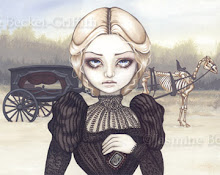 |
| Pinchbeck oval swivel brooch, centre section showing woven hair. |
 |
| Same as above, this time with the curl of hair shown. |
 |
| The swivel function. |
 |
| Close up of engraved detail. |
The style and production of this brooch is typical of the Victorian period. It is likely that the brooch is one of many types that could be ordered and then customised to the wears specification. As we have seen this brooch features two compartments containing hair-work, in other examples the hair could be replaced with miniature paintings, fabrics, cameos and even photographs of a loved one when technology allowed it.
It may only be a simple brooch, of common place design and features no inscribed dedication but it is one that I adore. There is little out of the ordinary about how it came into my possession, it simply caught my eye while at a fair one sunny morning and, as is often the way, the stall owner was only too happy to dispose of this “macabre” item for a very small sum. Upon returning home the strange coincidences surrounding this brooch came to light. Proudly wearing my newest purchase I decided to pay a visit to my Nanny. As is customary in our household I removed my coat as I stepped over the threshold and went to hang it upon the peg opposite the door. She caught sight of my brooch and exclaimed with much bewilderment;
“Gosh, I cannot remember when I gave you that but I am so pleased you are wearing it”
After much deliberation, and consulting Nannys’ jewellery box, we finally stumbled upon the answer. I had unknowingly purchased an exact copy of a brooch Nanny owned (and still owns to this day). Her brooch passed to her through her Nanas’ family and was made to commemorate the memory of my 3rd great grandfather. According to Nanny as a little girl I would sit for hours and play with the pieces from her jewellery box, the brooch in question was a great favourite of mine. I would have been very young at the time and so have no recollection of this but a memory of sorts must have stayed with me, all be it sub-consciously. It is this introduction to mourning jewellery, and in particular Nannys brooch, at such a young age that I believe began my obsession with this subject.
So there you have it, a simple case study that goes on to reveal so much more. I leave you with the thought that everything happens for a reason even if that reason does not become clear instantly.
MM x



